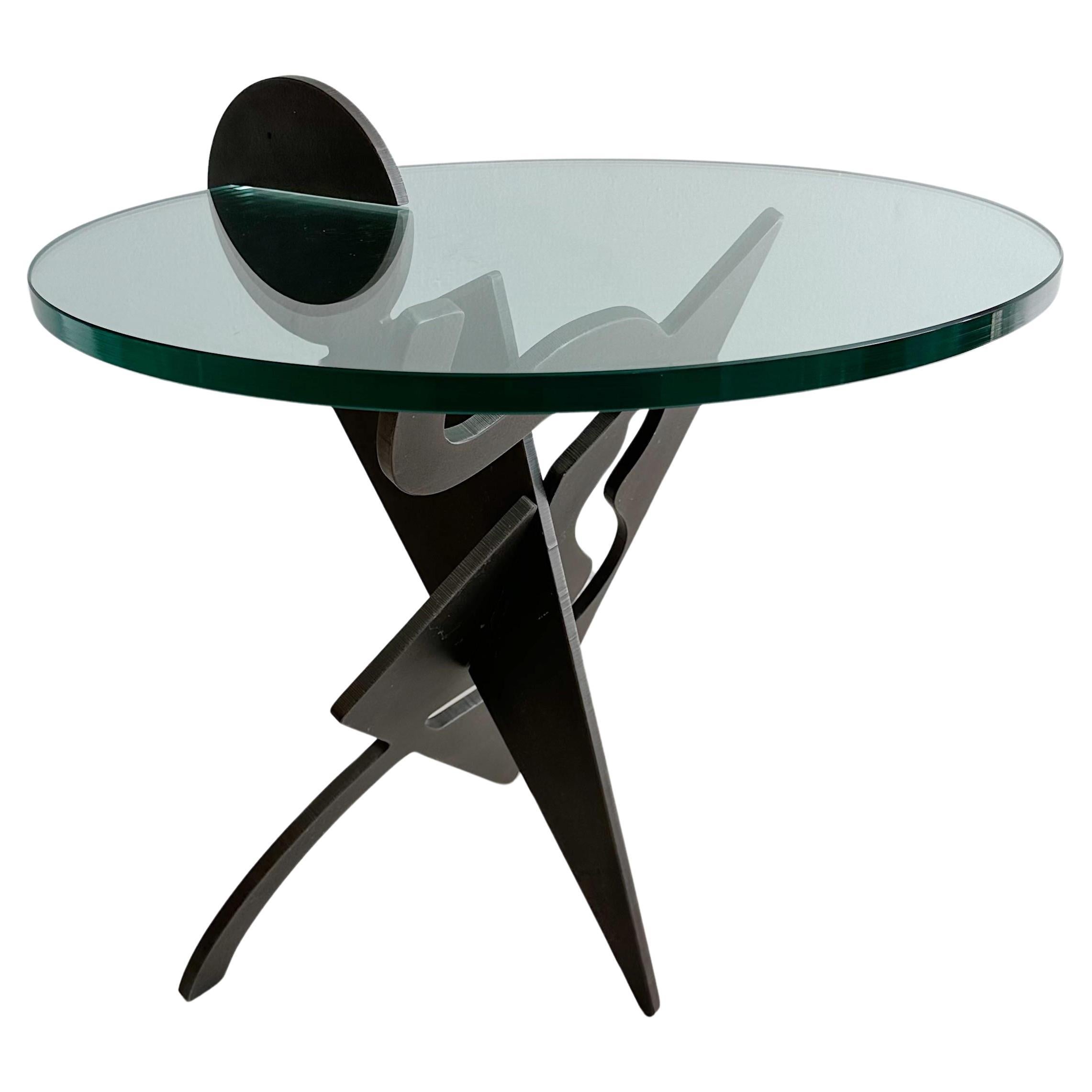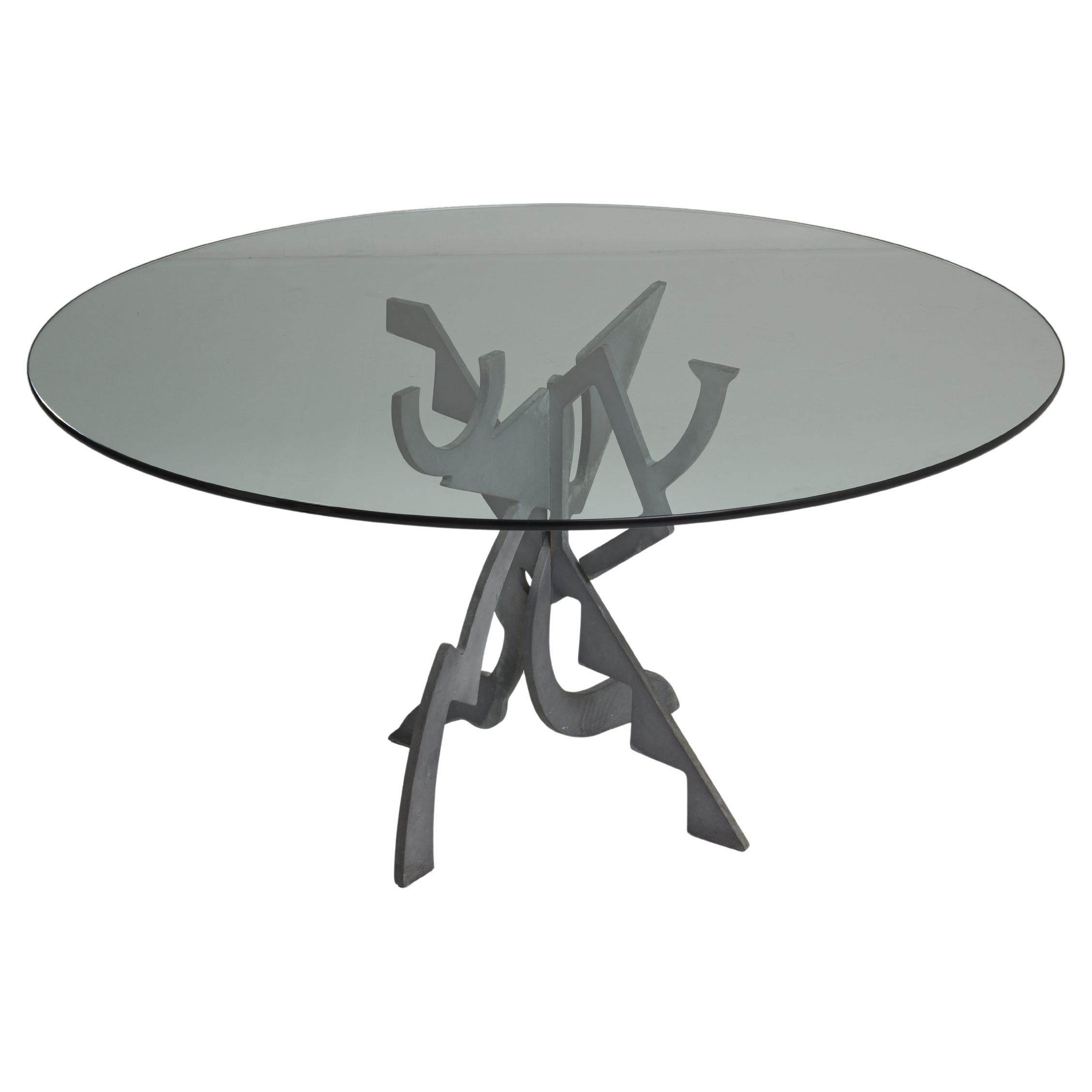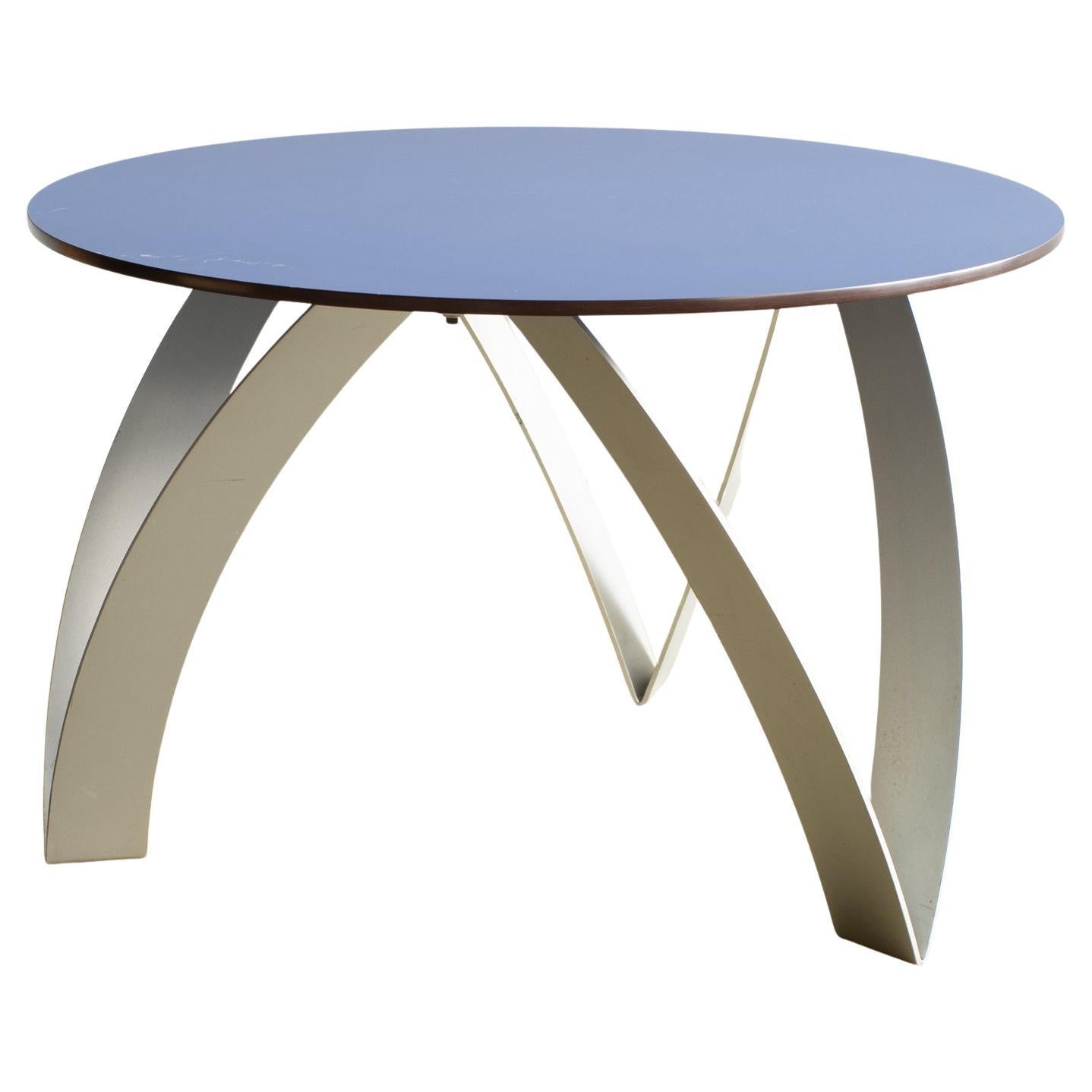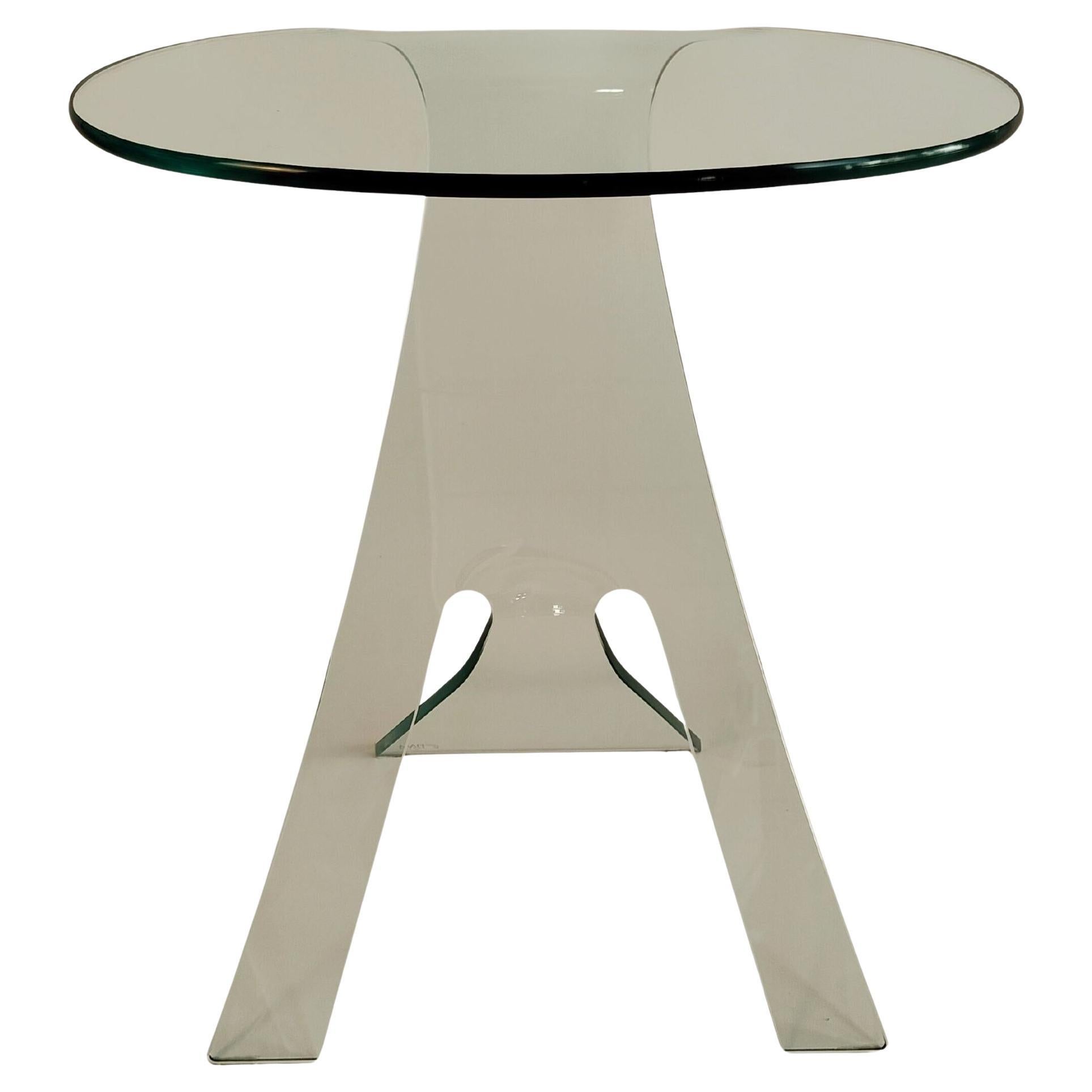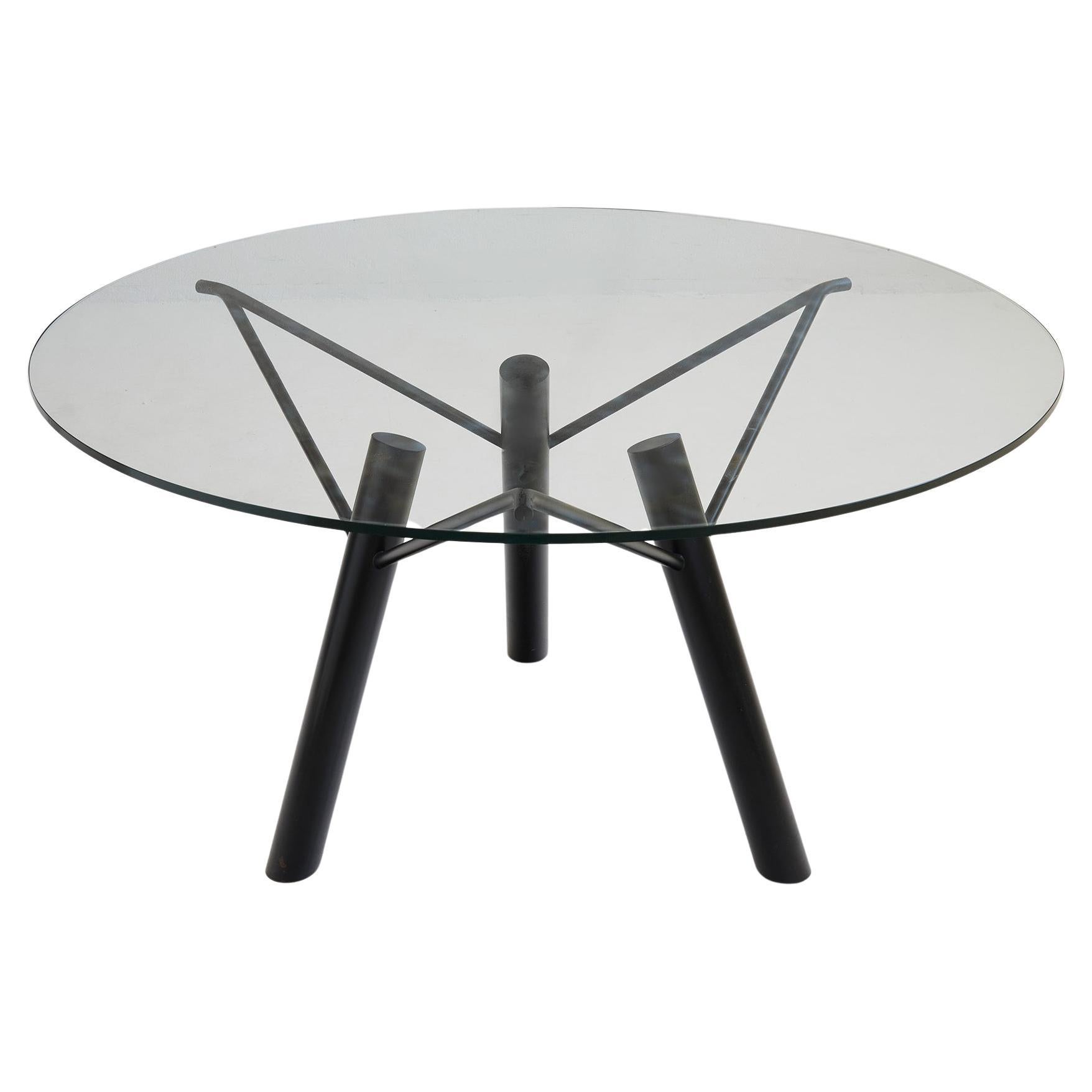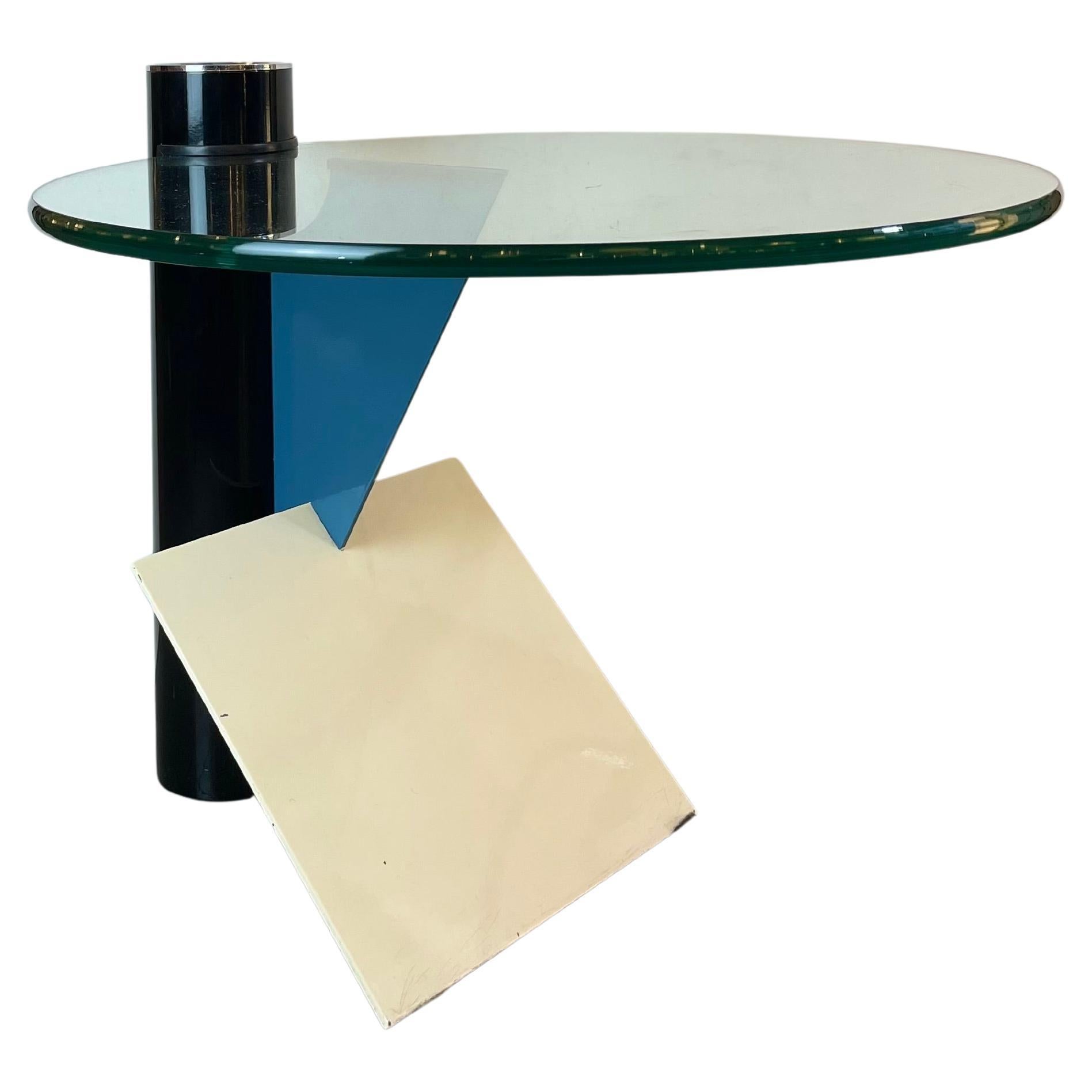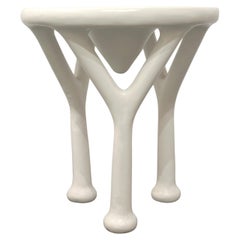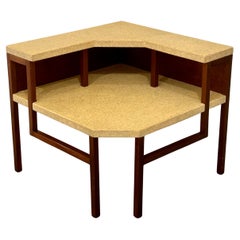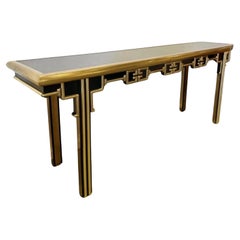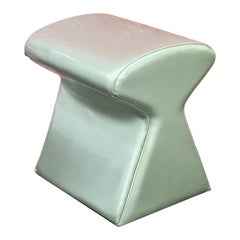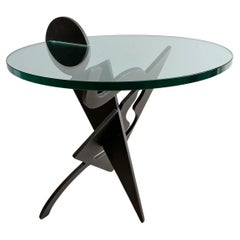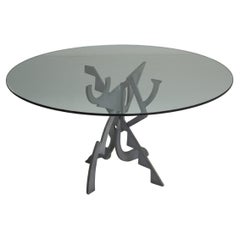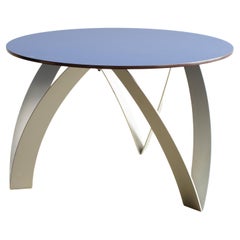Articles similaires à Pucci De Rossi for H Dolin Stuart Signed Battista Occasional Table, 1987
Chargement de la vidéo
Vous voulez plus d'images ou de vidéos ?
Demander au vendeur plus d'images ou de vidéos
1 sur 16
Pucci De Rossi for H Dolin Stuart Signed Battista Occasional Table, 1987
2 456,88 €
À propos de cet article
Pucci De Rossi for H Dolin Stuart Signed Battista Occasional Table, 1987
A delightful postmodern sculptural side table with an interlocking charcoal color metal base with glass top by Italian-born, Paris-based designer and artist Pucci de Rossi. Signed and dated 1987 at the base.
The. table measures 28" high x 23-1/2" wide x 22" deep overall. The glass top is 3/4' thick and measures 22" diameter. The glass top surface is 24-3/8" high.
There are some light scratches in the glass that are not distracting when viewed at a normal distance. There is a chip at the edge of the glass that presents as green but is hidden where the glass attaches under the frame so it is not seen. Otherwise, light scratches as expected in an item of this age, See photos for full condition. In rather remarkable condition for its vintage.
Among the army of designers from the 1980s and ’90s plucked from the archive in recent years — Ettore Sottsass, Nathalie du Pasquier, and their Memphis cohort, to name a few — there are still many that remain ripe for rediscovery. Our latest find is Pucci de Rossi, the Italian-born artist and designer who intrigued and confused the Parisian design world with his Brutti Mobili (Ugly Furniture). A clear predecessor to a whole cohort of artist-designers working today — think Misha Kahn’s mixed media chimeras — Pucci de Rossi didn’t invent the concept of functional art, but his work from the 1970s to 1990s certainly laid some groundwork.
Born in the Northern Italian city of Verona, Pucci was a tinkerer at heart. The trajectory of his practice simply followed what kind of materials were available to him at the time. In the early days, under the tutelage of American sculptor Brooks Walker, he worked with found objects, gathering old furnishings and discarded objects to create Frankenstein-like medleys inspired by the Surrealist paintings of Dalí and De Chirico at his home on the banks of the Adige river. “Pucci began his artistic life before the arrival of Postmodern design,” writes Nancy Huston in a monograph dedicated to his work, “at a time when no one raised the problems of the relationship between artists and artisans, and the word ‘design’ had not yet undergone the inflation that we know today.”
A contemporary of the Memphis movement, he held Ettore Sottsass and his ilk in high regard, but, recalls his widow, gallerist Mathilde Baralhé: “Pucci did not define himself as a designer but more as a visual artist, he designed his own objects and very rarely worked for serialization. He was therefore not constrained by any technical specifications and could let his imagination run wild. He was a creator of forms in space which kept a function to his creations. Pucci was a sculptor who played with furniture, shapes, materials and styles.”
In the 1970s, Pucci left Vicenza and moved to Paris with his first wife, the French writer and artist Laure Vernière. Arriving in the capital signaled a creative boom time for Pucci. From his flat in the Bastille district, he would scour the streets collecting detritus from the artisans and craftspeople that populated the neighborhood, which he would then transform into his infinitely kinetic assemblages: “Zinc torn off the roof by the roofers, abandoned furniture, debris of all sorts could be found on the sidewalks. All these materials, tools, bistro awnings, old signs, ordinary wood, wire, plastic… were a gold mine for me… I could find everything in the neighborhood. After, came the idea,” he once said.
In the monograph, Huston describes these amalgams as anthropomorphic furniture. “The seats can’t stand still,” she writes. “Structures are crossed by fluid forms; struck by a cramp, a Chippendale leg becomes taut, its lion’s claws have dropped their ball. The seats become animated, their backs, their legs and their arms start to move. An Art Nouveau curve balances a molding with a right angle, improbable compartments with their knobs act as the left arm. Under the undulating seat are four disparate legs: a baroque scroll, a baluster and two geometric volumes. Asymmetrical, dislocated, lop-sided, the monster leaning on its crutch seems to raise its shoulder to start a burlesque dance or to flee, like Dr. Frankenstein’s creature or the furniture of Maupassant’s short story.”
Despite his prolificacy, it wasn’t until the mid-80s that Pucci could be tacked on to a coherent design movement. As his profile grew, he became known as the continental answer to the group called ‘The London Scrapdealers’ — an ad hoc movement made up of André Dubreuil, Tom Dixon, Mark Brazier Jones and Nick Jones who similarly employed found objects and contorted junk metal in their work. It was a mode of working that was unstudied and untaught, a reaction to the 1980s chrome-plated minimalism. “People were fed up with the minimal, they wanted curves and what they liked was the salvaging aspect, messed up, Arts & Crafts, to use the English term. We didn’t do drawings, we executed spontaneously,” Dubreuil said of the early Postmodernists. Finally, the style Pucci had been nurturing for decades was having a moment.
It was around this time that Pucci began working with Paris gallery Néotu, where he would produce a succession of collections in his proto-Nickelodeon aesthetic. Distorted furniture inspired by Dali (Hommage à Dalí, 1989), deconstructivist-style three-dimensional collages in metal and wood (Introibo ad altare dei, 1987) lamps spliced with shards of glass (Le Gardien du trésor, 1985), undulating plywood monoliths (Trois Fois rien,1991) and steampunk-like assemblages of wooden artifacts gleaned from forgotten chairs (Remake, 1993) all became examples of Pucci’s dogged eclecticism.
Paris also introduced Pucci to the kind of patrons who would allow his creative impulses to run free. The most influential among them was auctioneer Jean-Claude Binoche, known for his contemporary art and design sales, who commissioned Pucci to design the dining room and office in his Paris home, and later on, his sprawling Palazzo in Venice, which would become the most fully realized expression of Pucci’s idiosyncratic melding of art and design. A built-in sleigh bed formed in the shape of baroque scrolls, hand-painted technicolor murals on the building’s ancient rafters and furniture plucked from Pucci’s various collections over the years made up the extravagantly bizarre Venetian home.
“A man apart, gifted with overflowing ingenuity and inventiveness. It was not always easy to follow his thoughts every day, he was always thinking about the meaning of things, of life, of himself,” recalls Mathilde, who lived with Pucci at his Bastille apartment until he passed away in 2013.
Of his legacy, she writes: “The object that reflects this feeling is the J.A.R. mirror (Jamais Assez De Reflection/Never Enough Reflection), on one side a mirror, on the other a self-portrait. But unlike many other artists, Pucci was not self-centered, he was very available with his friends and relatives. He was very sensitive to people. He could be light and deep at the same time. He followed the impulses of his heart. But he was also a bon vivant who liked to party. What I liked about him was his humor, his mischievousness and the offbeat vision he had of the world: ‘I have to constantly change the reality that surrounds me, my work is an example of this and it is perhaps the way of expressing myself that suits me best’ [he once said]. Living with Pucci was like living a daydream. He was an everyday poet.”
Source: Sight Unseen
- Créateur:Pucci De Rossi (Designer)
- Dimensions:Hauteur : 71,12 cm (28 po)Largeur : 59,69 cm (23,5 po)Profondeur : 55,88 cm (22 po)
- Style:Postmoderne (De la période)
- Matériaux et techniques:
- Lieu d'origine:
- Période:1980-1989
- Date de fabrication:1987
- État:Usure conforme à l'âge et à l'utilisation. There are some light scratches in the glass that are not distracting when viewed at a normal distance. There is a chip at the edge of the glass that presents as green and but is hidden where the glass attaches under the frame.
- Adresse du vendeur:Cathedral City, CA
- Numéro de référence:Vendeur : OC98651stDibs : LU8352245433332
À propos du vendeur
5,0
Vendeur professionnel agréé
Chaque vendeur répond à des normes strictes en matière d'authenticité et de fiabilité
Établi en 2000
Vendeur 1stDibs depuis 2023
23 ventes sur 1stDibs
Temps de réponse habituel : <1 heure
- ExpéditionRecherche du devis...Expédition depuis : Cathedral City, CA
- Politique des retours
Certaines parties de cette page ont été traduites automatiquement. 1stDibs ne garantit pas l'exactitude des traductions. L'anglais est la langue par défaut de ce site web.
Plus d'articles de ce vendeur
Tout afficherTable en Y laquée John Dickinson, vers 1970
Par John Dickinson
Table en Y laquée John Dickinson, vers 1970
Il s'agit d'une rare table Y (modèle 118) en résine laquée, conçue par John Dickinson. Il s'agit d'une table spéciale qui s'adapterait à ...
Catégorie
Vintage, années 1970, Américain, Organique, Tables d'appoint
Matériaux
Résine, Laque
Table d'angle en liège et acajou de Paul Frankl pour Johnson Furniture, vers 1951
Par Johnson Furniture Company, Paul Frankl
Paul Frankl pour Johnson Furniture Table d'angle en liège et acajou, vers 1951
Grande table d'angle unique qui conviendrait parfaitement à deux grands canapés du milieu du siècle di...
Catégorie
Milieu du XXe siècle, Américain, Mid-Century Modern, Tables d'appoint
Matériaux
Acajou, Bouchon
Console Mastercraft USA élégante en laque noire et laiton, vers 1970
Par Maitland Smith
Console Mastercraft USA élégante en laque noire et laiton, vers 1970
Superbe et longue table console Mastercraft en laque noire et laiton avec motif de clé grecque. Il s'agit d'une...
Catégorie
Vintage, années 1970, Américain, Hollywood Regency, Consoles
Matériaux
Laiton
Tabouret de chambre en vinyle argenté Karim Rashid pour IDEE, édition limitée, signé et numéroté
Par Karim Rashid, Idée Japan
Tabouret Shroom de Karim Rashid conçu pour IDEA, Japon en 1998. Cette version en vinyle argenté était une édition limitée et est signée et numérotée #4/57 sur le tissu étiqueté IDEA ...
Catégorie
années 1990, Japonais, Futuriste, Tabourets
Matériaux
Tissu d'ameublement, Synthétique, Mousse, PVC
Yasha Heifetz Lampe de table Rotaflex surdimensionnée, vers les années 1950
Par Heifetz Rotaflex, Yasha Heifetz, Heifetz
Lampe de table Rotaflex de Yasha Heifetz, vers 1950
Rare version de la lampe Heifetz Rotaflex avec un abat-jour en plastique filé qui repose à l'intérieur d'un réceptacle en laiton ...
Catégorie
Milieu du XXe siècle, Américain, Mid-Century Modern, Lampes de bureau
Matériaux
Métal, Laiton
Vase à motif abstrait incisé et décoré à l'engobe par Lee Rosen Design Technics vers les années 1950
Par Lee Rosen, Design Technics
Lee Rosen for Design Technics Vase à motifs abstraits incisés et décorés à l'engobe, vers les années 1950
Il s'agit d'un magnifique et unique vase Design/One de Lee Rosen qui se car...
Catégorie
Milieu du XXe siècle, Américain, Mid-Century Modern, Vases
Matériaux
Céramique, Poteries
Suggestions
Pucci De Rossi (1947-2013) Table d'appoint "Battista
Par Pucci De Rossi
Pucci De Rossi
(1947-2013)
Table d'appoint composée de deux panneaux d'acier de ⅝" d'épaisseur emboîtés l'un dans l'autre et découpés en formes abstraites, avec un morceau de verre n...
Catégorie
Vintage, années 1980, Américain, Mid-Century Modern, Tables d'appoint
Matériaux
Acier ajouré
Table Sculpture Pucci De Rossi 'Tristan et Isolde' H. Dolin Stuart France 1987
Par Pucci De Rossi
PUCCI DE ROSSI (1947-2013) & H. DOLIN STUART
Table "Tristan et Isolde", conçue en 1978, produite en 1987, structure en acier laqué gris et plateau en verre.
Édition Neotu
H 73,5 × Ø ...
Catégorie
Vintage, 1980s, French, Moderne, Tables
Matériaux
Fer
Table d'appoint Kioko De Pas, D'urbino, Lomazzi postmodern 80s style
Par Zanotta, Gionathan de Pas & Donato D’Urbino & Paolo Lomazzi
Table d'appoint Kioko conçue par De Pas, D'urbino, Lomazzi. Ce tableau a été publié au début des années 90. Les jambes sont probablement en aluminium. Le plateau de la table est en b...
Catégorie
Vintage, années 1980, italien, Postmoderne, Tables d'appoint
Matériaux
Acier
Table basse "Grillo" de FIAM Italia Vittorio Livi, cristal incurvé, Italie, 1980
Par Vittorio Livi, FIAM
Table basse Grillo en verre incurvé conçue par Vittorio Livi pour FIAM Italia vers les années 1980. Une seule feuille de verre bombé de 62x53x39 cm et de 12 mm d'épaisseur. Un design...
Catégorie
Vintage, 1980s, Italian, Postmoderne, Tables d'appoint
Matériaux
Cristal
Table de salle à manger "Orrido Canyon" par Mireille Rivier et Paolo Pallucco, Italie 1987
Par Pallucco, Paolo Pallucco & Mireille Rivier
Table de salle à manger "Orrido Canyon" par Mireille Rivier et Paolo Pallucco, Italie 1987
Il est doté d'une base de forme sculpturale avec trois pieds cylindriques angulaires. A to...
Catégorie
Vintage, années 1980, italien, Postmoderne, Tables de salle à manger
Matériaux
Métal
Table d'appoint postmoderne Memphis de Peter Shire pour Saporiti, années 1980u2028
Par Saporiti, Peter Shire
Rare table d'appoint postmoderne Memphis composée d'une base en acier émaillé noir, bleu et beige avec un plateau en verre et un vide-poche chromé. Conçu par Peters Shire pour la mar...
Catégorie
Vintage, années 1980, italien, Postmoderne, Tables d'appoint
Matériaux
Acier, Chrome
